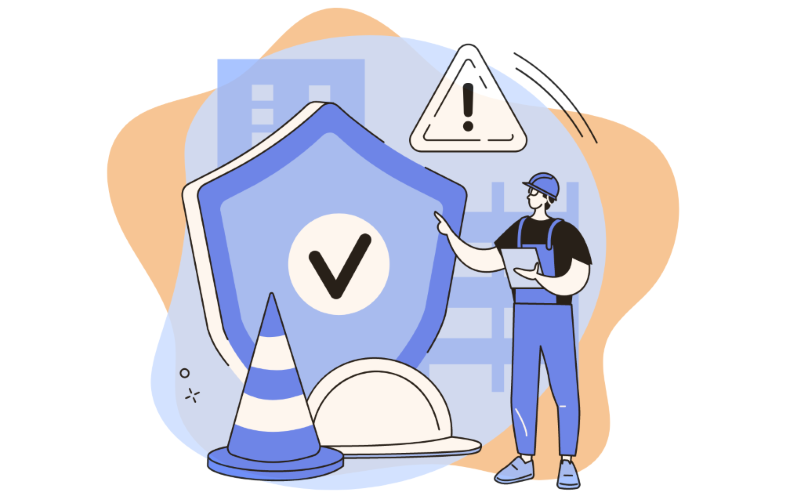Meeting Trucking Industry Health and Safety Obligations With Intuto
Trucking is an extremely high risk industry, and therefore must adhere to stringent health and safety laws. However, due to its decentralised and...
4 min read
Nick Warrick - All Seasons Uniforms : May 25, 2023 2:14:00 PM

Recent workplace safety data shows that 4,472 preventable injury-related deaths happened in a one-year period in the US. During the same period, 4,260,000 medically consulted injuries also occurred.
When leaders make workplace safety a priority, everybody benefits. If you’re not sure where to begin when it comes to increasing safety and your company, this guide can help.
Below are some specific strategies managers and employers can take to create a safety-focused company culture.
An excellent starting point is to ensure your company is compliant with the most recent Occupational Safety and Health Administration (OSHA) guidelines.
The following are some examples of essential OSHA compliance requirements:
OSHA offers quickstart guides on the organization’s website with complete checklists you can consult.
It’s not enough for a company to have safety plans in place. They must also make sure employees are aware of those safety plans and know how to respond when an accident or emergency occurs.
Employees should understand the specific steps they must take to protect themselves and their coworkers in various situations, such as when a machine malfunctions, a hazardous substance is spilled, or a fire starts.
Completing this safety training should be a prerequisite for all employees before they can progress and start executing the various responsibilities associated with their jobs.
All team members should also receive ongoing training so they can keep safety protocols at the top of their minds. These ongoing training sessions also ensure they’re aware of any updates or changes.
Detailed and precise checklists help employees know exactly what they should do in a given situation. These checklists can also ensure employees don’t skip critical steps when carrying out specific tasks (such as using a piece of machinery).
In addition to distributing checklists to each employee, consider displaying them in prominent locations throughout the building as well. That way, employees have no excuse not to follow a particular protocol and have a friendly reminder readily available in case they forget something.
A safety audit involves a rigorous review of a company’s operations, work environment, and culture. These audits alert you to potential safety risks and provide insight into how you can address them.
The following are the most common types of safety audits you might conduct:
Regular audits allow you to identify areas where your safety program might be lacking and give you a chance to make positive changes before an accident occurs.
A company culture that discourages employee feedback or reporting is not one that prioritizes safety. Employees must feel confident that they can share feedback or report accidents without being punished or criticized.
Encourage team members to offer insights into how workplace safety can be improved. They should also understand the importance of reporting accidents, malfunctioning equipment, etc., immediately rather than waiting until a problem escalates.
It helps to have a multi-faceted reporting and feedback system. That way, employees who are worried about expressing concerns face-to-face can send a message virtually or in writing to get their point across.
A clean workplace is a safe workplace. Make sure employees understand the importance of cleanliness, especially when it comes to preventing slip, trip, and fall accidents.
To help employees keep workspaces clean, leaders should create schedules to ensure team members tidy up regularly.
These schedules prevent messes from piling up on busy days. They also make cleaning more manageable and ensure one employee isn’t getting stuck with all the work.
Proper Personal Protective Equipment (PPE) is essential to OSHA compliance and general employee safety.
All employees should have access to protective clothing and other types of gear (such as face masks or respirators) that keep them safe from the hazards of their jobs.
It’s vital for employees to understand why certain pieces of clothing or safety gear are required. They should also have well-fitting options that provide maximum protection without compromising comfort or ergonomics.
When employees work for too many hours in a row without a break, their physical and mental health suffers. They’re also more likely to make mistakes that could jeopardize their safety (or their colleagues’ safety).
To prevent these issues from happening, employees should have regularly scheduled breaks for lunch and rest throughout the day.
No federal laws exist regarding employee breaks. However, many states have specific provisions in place, and employers should take care to abide by those rules to avoid legal issues and penalties, as well as compromised employee safety.
Many employers think of workplace safety as something related to machinery, proper lifting techniques, and adequate protective gear. It’s important to note, though, that a safe workplace is also one that prioritizes clean indoor air.
Good air quality and adequate circulation ensure employees work in a safe and comfortable environment. Poor air quality can also lead to problems like headaches, breathing difficulties, and difficulty concentrating.
In addition to abiding by OSHA-specific rules regarding ventilation and pollutant levels, employers should also incorporate additional strategies, such as carbon monoxide testing and monitoring supplies that assess chemicals and vapors in the air.
Making workplace safety a priority improves employee productivity, job satisfaction, and overall performance. Follow the guidelines discussed above to improve workplace safety and make it a cornerstone of your company.
About the author:
Nick Warrick is the Sales Manager at All Seasons Uniforms. With over 15 years of experience in the work uniform business, he has worked with over 100 clients across 20 different industries. Holding bachelor’s degrees in both Business Administration and Information Technology, Nick revamped the company’s online presence, offering its customers a new uniform shopping experience.

Trucking is an extremely high risk industry, and therefore must adhere to stringent health and safety laws. However, due to its decentralised and...

With the recent changes in the Health and Safety at Work Act getting a bit of news lately, we thought we should take a good look at the implications...
Since the introduction of the Health and Safety at Work Act 2015, concerns have been raised that the emphasis on the punitive measures of the new...